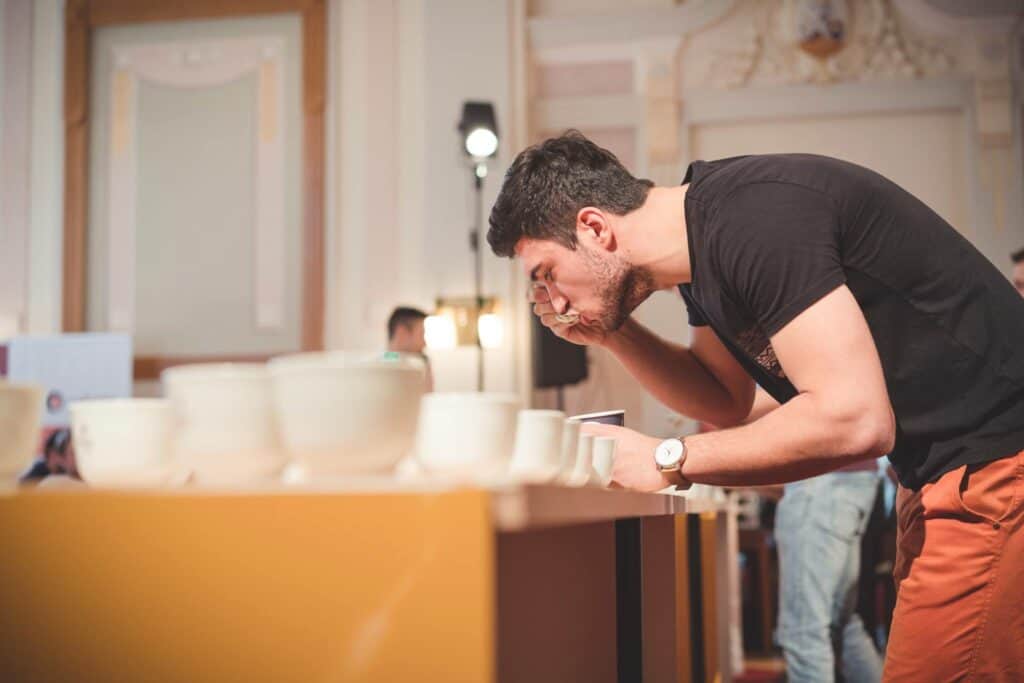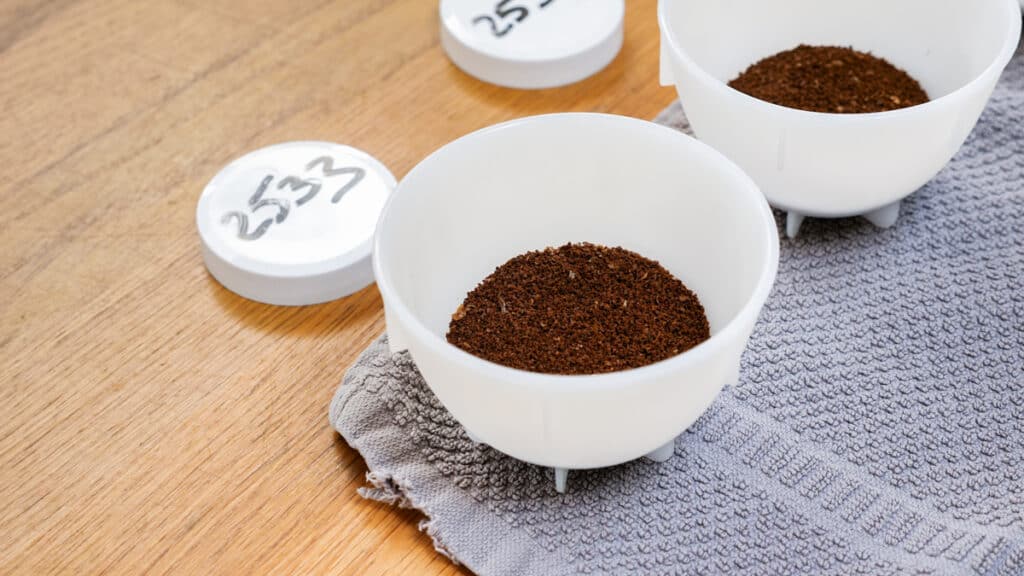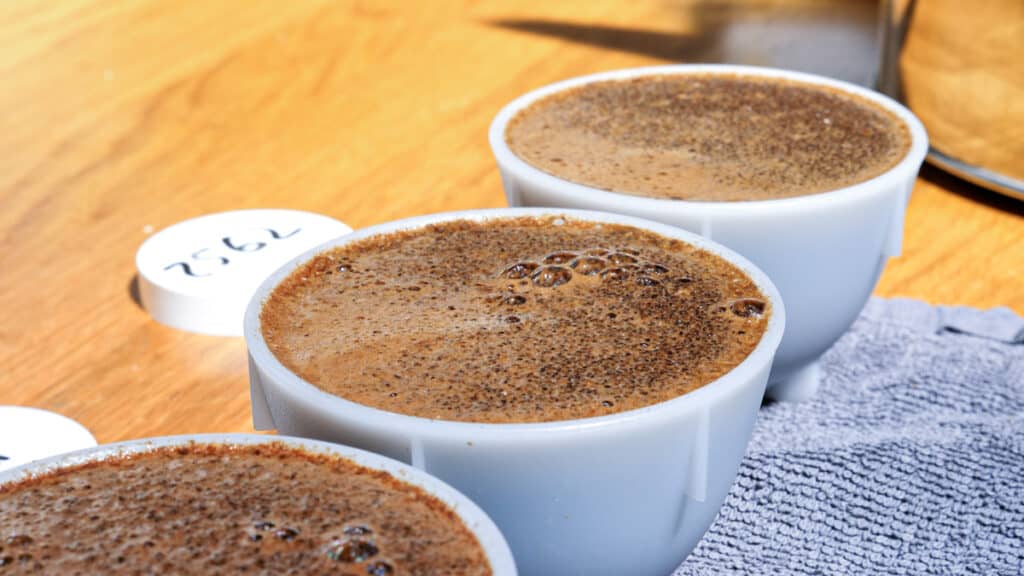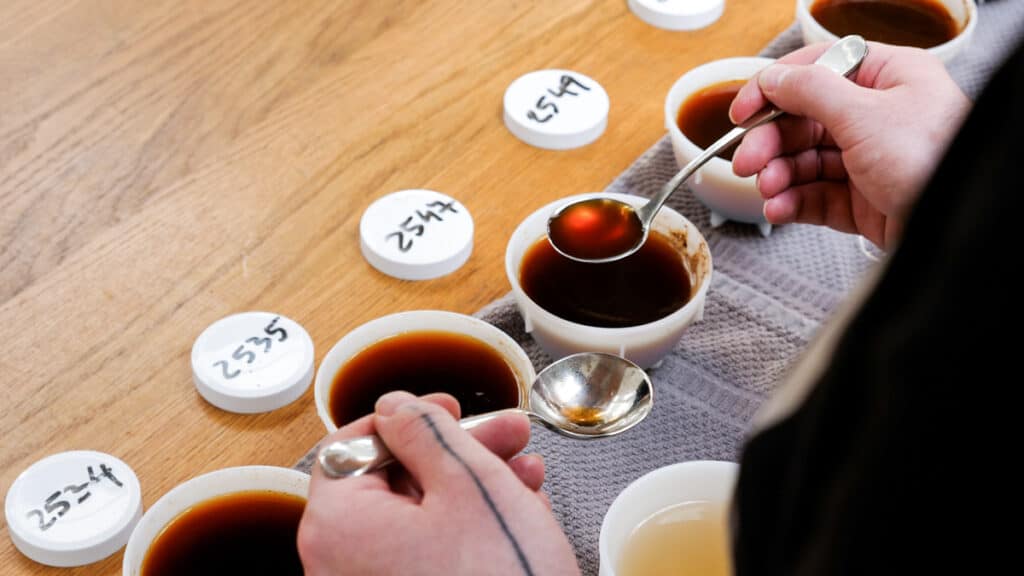It is said that only about 30% of trainees pass this certification. Thanks to my prior industry experience, I passed all 19 tests on my first go. Below, I want to share my experience of the Q Grader exams, so that you know what to expect, as well as my top tips for passing these notoriously tricky exams.

Q Graders are licensed degustateurs, who can expertly judge the quality of the coffee they drink. As I write this article, there are only about 7000 Arabica Q Graders in the world. It’s a certificate that is made for those who are very serious about coffee. Who else would sign up for the hardest coffee exam in the world, which takes a week to complete and costs around €2000?!
Currently, there are 2 types of coffee quality-assessing Q Graders. Arabica Q Graders evaluate whether Arabica coffees pass the quality check required to be labelled as “specialty coffee”. Then, Robusta Q Graders do the same thing but for canephora coffees, and for these we use the term “fine grade coffee”.
The assessment will award fair, calibrated scores to the coffee, and the decision should be given in common coffee terms that can be understood anywhere in the world. Coffee should be evaluated in the same way with the same results, wherever in the world it may take place. Certificates are then issued by the Coffee Quality Institute (CQI) – the organisation that established the program around 2003.
What is the Q Grader exam about?
The whole certification took 5 to 6 days to complete, and I flew from Prague to Amsterdam to take the exams. The course was organized by the Daarnhouwer company, which imports green coffee beans and commodities from around the world.
For the first three days, we went through trial tests as a practice. Our lecturer – Luz Stella Artajo Medina, along with her assistant Ronald Spoor – led us through all the areas required for the general knowledge exam and the other tests. This was the best part of the experience because it gave you an idea of exactly what to expect in the upcoming days.
The other 2-3 days were significantly harder. Starting in the morning and finishing in the evening, we went through the 19 tests all day, without knowing whether or not we passed them until the very end.

A Breakdown of the Q Grader Exam
- Cupping (4 tests)
- You will cup and evaluate coffees of different qualities. The types of coffees used in this stage can be separated into 4 groups: Milds, African, Asian and naturals.
- You will cup and evaluate coffees of different qualities. The types of coffees used in this stage can be separated into 4 groups: Milds, African, Asian and naturals.
- Triangulations (4 tests, using the same coffees as you did in the cupping tests)
- This was fun – like a little cup tasting competition. You will have three cups in front of you, two of them will contain the same coffee and one will be different. You have to distinguish which one is which based on cupping (using smell, break crema and the like).
- This was fun – like a little cup tasting competition. You will have three cups in front of you, two of them will contain the same coffee and one will be different. You have to distinguish which one is which based on cupping (using smell, break crema and the like).
- Acids in coffee (1 test)
- Identify one of the four basic acids present in weak filter coffee.
- Identify one of the four basic acids present in weak filter coffee.
- Olfactory (4 tests)
- Identify aromas from Le Nez du Cafe set.
- Identify aromas from Le Nez du Cafe set.
- Sensory skills (2 tests)
- Identify basic tastes and their intensities in water solutions.
- Identify basic tastes and their intensities in water solutions.
- Roast sample ID (1 test)
- Differentiate between an underdeveloped roast, an SCA standard roast, and overdeveloped roast and strongly baked coffee.
- Differentiate between an underdeveloped roast, an SCA standard roast, and overdeveloped roast and strongly baked coffee.
- Green and roasted coffee grading (2 tests)
- You will count the defects present in a green coffee sample. It helps to know all the potential green bean defects by studying the SCA Green Coffee Defect Guide. (TIP: just because a bean is ugly, this doesn’t mean it’s a defect!) Then, in the roasted coffee sample (100 grams), you will have to check to see if there are any quakers.
- You will count the defects present in a green coffee sample. It helps to know all the potential green bean defects by studying the SCA Green Coffee Defect Guide. (TIP: just because a bean is ugly, this doesn’t mean it’s a defect!) Then, in the roasted coffee sample (100 grams), you will have to check to see if there are any quakers.
- General knowledge exam (1 test)
- Most of the information required for this can be gained from SCA booklets and websites, and from your lecturer, so listen carefully!
How to train for the Q Grader exam?
Without a doubt, the training was challenging. There were no active Q Graders in the Czech or Slovak Republic. But I would recommend that you get in touch with other Q Graders (wherever they may be based) and ask them for their advice.
Also, for the training you will need to have access to lots of coffees, so you should find a partner – a roastery or green buyer firm would be a perfect fit – especially if you don’t evaluate coffees regularly in your day job.
I had about a month to prepare, and this was enough time to balance everything alongside full-time work. At the time, I worked as a barista trainer and a Quality Control Manager. If you are not so experienced, or you do not work in a roastery or a green buying firm, allocating 2 months for training should be fine.
Since I used to compete in Cup Tasters competition, I was able to use some training techniques that I had already learned for the Q Grader as well.

It depends on the person, but in some ways, I found that it is good to monitor your diet a bit during this period. Do not get completely wasted, do not drastically change your diet, and try to avoid strong-flavoured foods (such as very strong chilli, or too much onion and garlic). Also, remember that there is only so much sensory training that you can do in a day. Over-tasting will lead to palate fatigue.
Schedule your training wisely. If possible, fit in one practice before work and one after work. Try to include a few practice sessions where you are feeling tired or saturated because you might find that you feel this way during Q Grader certification.
The basics work wonders. During the Q Grader certification, get a lot of rest and sleep, have good food and stay hydrated, as keeping well is a simple way to boost your abilities.
The Training Plan for Passing the Exam
Here are the most important things that you will need to train for:
1 – Coffee cuppings
This is definitely the most important part of the whole certificate. During your training period, make a schedule that outlines how many coffees you will aim to cup each week.
The goal: cup as many coffees as possible, follow the protocols and use the SCA cupping form to get used to it. I cupped and scored at least 8 – 12 coffees four times a week – that’s about 128 – 192 coffees which translate to 640 – 960 single cups of coffee scored during the training period (because each coffee consists of 5 cups)! Although I didn’t always use new types of coffee each time, this regular cupping made for great exam practice.
Use different sources to get your coffee: this could be the roastery where you work, leftover samples and a number of coffees from other roasteries as well.
Divide your cuppings into the 4 groups of milds, African, Asian and naturals (as you would like in the certification). I didn’t have enough cups for a full table of 6 coffees, so I trained with 4 – 5 coffees per set, but I always used five cups per table.
Regularly go back to your notes, and talk about the differences between the coffees with your colleagues. If possible, get samples of coffees which range from 70 – 87 points. But if you can’t access these, don’t stress – you will get the chance to calibrate in the first three days of the Q Grader certification.
2 – Taste acids
This test is particularly hard, and so it is wise to train beforehand. You can buy a set of basic acids online in organic chemistry kits. In the certification, you will only have to identify four: citric, malic, acetic and phosphoric acid.
I would recommend firstly tasting each one in water, and then moving on to taste them in filter coffee. Write down notes about the sensations that each one evokes on your tongue and how the acid changes a coffee. It is all about the perception that can be sensed on the tongue.
3 – Sensory solutions
You can easily set up a replica of this test by yourself. In the certification, you will only be required to use three basic tastes: sweet, sour and salty. You can mix these solutions in water. You should prepare three bottles (intensities) for each taste: strong – 3, medium – 2, low – 1.
Below, you can see how to make up the strongest (3) intensity recommended by SCA. With the medium and low-intensity mixtures, it is up to you how weak you make them. You could try around 70% for medium, and 30-40% for low intensity. Taste the mixture, and see if you can spot each taste in the lowest intensity.
Practice routine:
- Prepare 9 cups (3 tastes, 3 intensities). Label the cups on the bottom, mix them.
- Taste each one, and put them in order of taste from the lowest to highest intensity.
- Use the bottles from exercise 1) to prepare 8 mixtures, 4 of which contain 2 solutions, and 4 of which contain 3 solutions. Again, label each one on the bottom and mix. You have to try and guess the taste and intensity of the cup (eg: identify a sample with 3 mixtures and the strength of each as salty 3, sweet 2, sour 1).
The intensity of solution in the SCA Sensory Course:
Sweet – sugar 24g / 1000ml of filtered water
Sour – citric acid 1,2g / 1000ml of filtered water
Salty – salt 4g / 1000ml of water
Bitter – caffeine 0,54g / 1000ml or mix tonic water without sugar with filtered water
4 – Olfactory
In the Q Grader certification, you will have to distinguish aromas from the Le Nez du Cafe box. Buy (or borrow) a set of these aromas and learn to identify them all blindly.
Warning tip: I trained with a box of aromas that was over 10 years old, and some of the samples were stale so that they smelled differently from the ones used in the exam.
Is Q Grader certificate worth the hassle?
I think that, in the end, going through all the stress, preparations and the exam itself was all worth it. The Q Grader certification will help you understand coffees in more depth than probably any other training could. You will learn from experienced instructors, as well as your fellow classmates. You will get feedback on how you perform like a coffee cupping expert.

Many people think that they are already doing things the right way. Although this might be true, it is important to benchmark this practice with some kind of standards, to understand them and communicate coffee measurements in defined terms, so that we can all work together across the coffee industry.
The Q Grader helped me to become more confident with cuppings. I graded all the coffees that we had in stock and calibrated them with the whole team. I prepared and trained baristas as a better lecturer. My colleagues in the coffee industry hold a kind of respect for the certificate. It might open many doors for you, and it will surely secure you a number of employment opportunities.
Now that I am a Q Grader, I can provide guidance and quality control to other roasters. I think we should definitely have more Q Graders in the world, and I think that, one day, there will be an even harder form of coffee certificate, like wine experts have in their industry. Perhaps, you will have to demonstrate your skill in roasting, brewing techniques, or have a wider knowledge of processing or know a vast number of varieties and their characteristics…
Who knows, a new generation of Super Q Graders might be coming!

